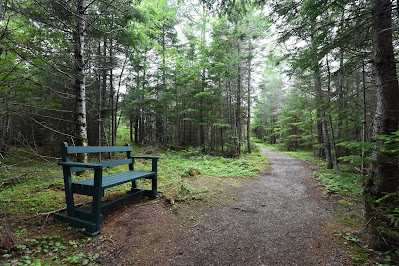Important Bird Areas and Kissing a Cod : A Day in Doyle
With only 40 km left before we leave Newfoundland behind on our #hike4birds across Canada on the Great Trail, we stopped for a day to visit the Codroy Valley Estuary Important Bird Area (IBA), which is also a RAMSAR Wetland Site.
The estuary is located where the Grand Codroy River flows into the Atlantic Ocean, and it is about 3 km wide and 12 km long. The site is bordered by roads, agricultural fields, and gently rolling, forested hills.
It was designated as an IBA because it provides important breeding and staging habitat for at least nineteen species of waterfowl. It also supports globally significant numbers of a subspecies of Canada Goose (North Atlantic B.c. canadensis population), which is about 1% of the Atlantic population of this species.
Other waterfowl species that can be found here include Wood Duck, Green-winged Teal, American Black Duck, Northern Pintail, Gadwall, Lesser and Greater scaup, and Common and Red-breasted merganser, and the site provides breeding habitat for Northern Shovelers, American Wigeons, and Blue-winged Teal.
This morning we walked from the Grand Codroy RV Park and Campround up to the Wetland Interpretation Center. This little center has lots of information on the Codroy Valley Estuary in various pamphlets and displays, as well as information on the birds of the area and how to help them, including by getting involved in various Citizen Science initiatives. In particular, a lot of information was provided on the endangered Piping Plover.
From the centre we walked the short woodland trail, which offered periodic views out into the estuary. We saw 28 bird species, both on the lovely, flat, winding forest trail and out in the estuary.
Highlights from the forested section included close-up views of a Black-and-White Warbler, Yellow-rumped Warbler, American Redstart, and Ruby-crowned Kinglet.
Along the edge of the marsh we watched American Goldfinches and Cedar Waxwings flitting about in the shrubs, and we enjoyed seeing Tree Swallows catching insects above the water, several Great Blue Herons making their way majestically across the sky, and two families of American Wigeons purposefully paddling past. Just as we reached the field at the end of the trail we saw a Northern Harrier swoop across the field at high speed.
Our visit to this Important Bird Area was thoroughly enjoyable. Afterwards we stopped for a bite to eat at Joe's Cafe, and then made our way back to the campground. Once back at our site we discovered a few avian visitors and watched for an hour while one particular hatchling chased its mother around the region begging for food.
In the evening we attended the "screeching in" ceremony in the Music and Friends cabin at the campground. During this ritual visitors to Newfoundland are generously offered a chance to become honorary Newfoundlanders by eating special food (bologna), dancing a jig and reel, drinking a Newfoundland beverage (Screech rum), and kissing a cod. There was live music, dancing, and lots of Screech, and good company all around.
The owners and operators of this family run campground are very friendly, helpful, and knowledgeable about the history, natural heritage, and recreational opportunities in the beautiful Codroy Valley, and they go out of their way to share this with their visitors. Here we found another example of the kindness, warmth, and offers of help we've received a cross the island.
The estuary is located where the Grand Codroy River flows into the Atlantic Ocean, and it is about 3 km wide and 12 km long. The site is bordered by roads, agricultural fields, and gently rolling, forested hills.
It was designated as an IBA because it provides important breeding and staging habitat for at least nineteen species of waterfowl. It also supports globally significant numbers of a subspecies of Canada Goose (North Atlantic B.c. canadensis population), which is about 1% of the Atlantic population of this species.
Other waterfowl species that can be found here include Wood Duck, Green-winged Teal, American Black Duck, Northern Pintail, Gadwall, Lesser and Greater scaup, and Common and Red-breasted merganser, and the site provides breeding habitat for Northern Shovelers, American Wigeons, and Blue-winged Teal.
From the centre we walked the short woodland trail, which offered periodic views out into the estuary. We saw 28 bird species, both on the lovely, flat, winding forest trail and out in the estuary.
Highlights from the forested section included close-up views of a Black-and-White Warbler, Yellow-rumped Warbler, American Redstart, and Ruby-crowned Kinglet.
Along the edge of the marsh we watched American Goldfinches and Cedar Waxwings flitting about in the shrubs, and we enjoyed seeing Tree Swallows catching insects above the water, several Great Blue Herons making their way majestically across the sky, and two families of American Wigeons purposefully paddling past. Just as we reached the field at the end of the trail we saw a Northern Harrier swoop across the field at high speed.
In the evening we attended the "screeching in" ceremony in the Music and Friends cabin at the campground. During this ritual visitors to Newfoundland are generously offered a chance to become honorary Newfoundlanders by eating special food (bologna), dancing a jig and reel, drinking a Newfoundland beverage (Screech rum), and kissing a cod. There was live music, dancing, and lots of Screech, and good company all around.
The owners and operators of this family run campground are very friendly, helpful, and knowledgeable about the history, natural heritage, and recreational opportunities in the beautiful Codroy Valley, and they go out of their way to share this with their visitors. Here we found another example of the kindness, warmth, and offers of help we've received a cross the island.
See you on the trail!
Remember to follow our entire adventure here : www.comewalkwithus.online



































Comments
Post a Comment